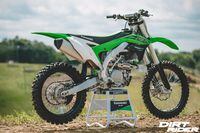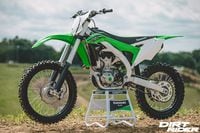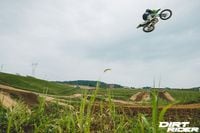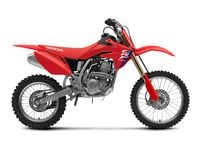The Kawasaki KX450 has been a top Dirt Rider 450 MX Shootout contender since its last major update, back in 2012. It was the first motocross bike to debut the now trending "launch control" and has often been praised for its strong engine character and straight-line stability on the track. Since then, it has seen minimal changes, with the exception of the Showa SFF TAC air fork that was introduced back in 2013. For 2016, Kawasaki tried to address some issues that we have been looking for in the green machine. During the KX450F press introduction, we got a technical presentation on the breakdown of changes on the chassis, suspension and engine. Kawasaki revised the cylinder head, the Cylinder is offset (8.5 mm forward), reducing friction and enabling more efficient power generation, revised intake valves and intake cam timing change are designed to complement cylinder exhaust system revisions, intake ports are less curved, revised intake cam timing (advanced 2-degrees), a piston crown design that matches the revised intake valves and maintains the compression ratio at 12.8:1, a new resonator effectively increases the exhaust pipe length and reduces exhaust noise volume by approximately 2 dB, excess meat was trimmed from transmission gears and shafts to reduce weight by approximately 260 grams (9.2 ounces), all-new aluminum perimeter frame offers revised rigidity from a slimmer and lighter layout, the radiator orientation has been turned inward to allow for a slimmer shroud design for improved ergonomics, oversized 270 mm front brake rotor, a redesigned flatter seat and fuel tank as the top of the fuel tank is lower, allowing an even flatter progression from the seat to the tank, intake ducts added below the rear of the seat (for improved throttle response), revised Showa suspension settings, and finally all new bodywork.
Kawasaki hauled us out to Mt. Morris, Pennsylvania last week at High Point Raceway, to spin some laps for a couple days and get a feel of what all these changes do out on the track. The Kawasaki KX450F has been referred to by testers the past couple years as heavy, bulky, and one of the more difficult bikes to corner in comparison to some of the other brands (like an RM-Z and CRF). For 2016 Kawasaki dropped 3.1 pounds off the chassis and an additional 4.4 pounds off the engine, resulting in a 7.5 pound overall weight savings compared to the 2015 model. The new frame spars are narrowed by 6mm, which resulted in a nimble and slimmer feeling bike on the track. The new frame lets the KX450F have increased front wheel traction and aid in front end control when we entered corners. It is now much easier to throw around in the turns and in the air, compared to last year’s model. Coming into corners the 16 KX450F lays into ruts easier and feels like there is front end traction, which is a huge difference compared to the rear steering feeling of 2015. Whipping the bike in the air takes less work and scrubbing jumps is made easier with the KX450F’s newfound lightweight feeling.
The big green machine has been one of the fastest and hardest hitting bikes in its class. At times it can even be too much for some, and this gets riders fatigued quicker on the track. For 2016, Kawasaki focused on making the engine character more manageable for the average rider. The initial aggressive bottom end hit has now been smoothed out and easier to ride. The Kawasaki now seamlessly transitions into a softer mid range hit of power, yet still pulls farther on top end than last year’s bike. We feel like you will have to use second gear a little more in corners with the 16 however, with the stock gearing, but going up one to two teeth helped us carry third gear better through corners. Kawasaki still offers three factory tuned DFI couplers for plug and play versatility that come with the bike. You can choose from a standard, aggressive, or a mellower “mud” setting that works well in slippery conditions where traction is an issue. To compliment the engine changes, Kawasaki finally designed a new exhaust featuring a resonator in the headpipe and a slightly smaller end cap on the muffler. These changes are good for a 2db reduction at the sound meter, which we have been asking for a while now. Kudos Kawasaki! On the track the exhaust note is much more friendlier now and you will not be waking up the dead when you start the KX450F now.
We see the return of the Showa SFF TAC fork for 2016 as well. It sports a revised valving setting to match the new lightweight chassis. They have reduced the damping force on the left fork and have a new set of low friction fork seals to combat stiction. We were lucky to have two Showa technicians present at the intro. Mark Braunwalder in charge of R&D and Osamu Kamiyama the general manager of Showa. Mark helped us play around with a bunch of different settings until we found something we were content with. We ended up going higher on the inner chamber pressure, down a little on the balance chamber and up to 20 psi on the outer chamber. This sounds confusing but by the time you read this, Showa should be releasing a mobile phone application that shows you how adjusting each chamber will affect the suspension on a dyno graph. The rear shock received a lighter and softer spring, and a new rear link and ratio to fit the chassis. The suspension changes worked really well on the track and were a big improvement over last year’s set up. The softer rear shock aids in helping with traction and comfort, yet still finds balance with the fork. Coming out of corners the rear end soaked up small chop impressively and on braking bumps the rear end sticks to the ground better than the 15 model.
Overall, we had a great time getting some seat time on the 2016 Kawasaki KX450F and getting acquainted with the changes. The bike is a great package with tons of adjustability in the suspension and engine. Not to mention, you can adjust the bar mounts forward or back and the foot pegs can be moved up or down by 5 mm to accommodate different sizes of riders and open up the rider triangle. Top that with a smoother engine character, balanced chassis, and a complete weight reduction, Kawasaki has definitely moved forward on an already good platform. We look forward to logging more time on the 2016 model at some rougher style tracks to see how all these changes really feel when the track is not as prepped as Mt. Morris was.









/cloudfront-us-east-1.images.arcpublishing.com/octane/JQ6LMK6LLBAQJIL2AH56UIUKWU.jpg)
/cloudfront-us-east-1.images.arcpublishing.com/octane/QUSF4LLRM5DDPCJW25RINQRJPE.jpg)
/cloudfront-us-east-1.images.arcpublishing.com/octane/FYDGK7GF4JBPXERA5RAZPY3YJI.jpg)
/cloudfront-us-east-1.images.arcpublishing.com/octane/JE7KMNASNRGR7FLYAFRZAR7T7E.jpg)
/cloudfront-us-east-1.images.arcpublishing.com/octane/7RCNKJJNXBF4LBKZXE2INNWZUY.jpg)
/cloudfront-us-east-1.images.arcpublishing.com/octane/BAGM5E4EWBHFNLZOXMSLOLKQGU.jpg)
/cloudfront-us-east-1.images.arcpublishing.com/octane/RSX65VBXY5FRLIY4LN6WLOKAFM.jpg)
/cloudfront-us-east-1.images.arcpublishing.com/octane/3EO2CNKWUFBGNMGNJPETW5HCNY.jpg)
/cloudfront-us-east-1.images.arcpublishing.com/octane/IYHM55XRNVHF3DSS3467PZ7ONQ.jpg)
/cloudfront-us-east-1.images.arcpublishing.com/octane/L7K3FIINEBHMZI2TXTUE4FXH7I.jpg)
/cloudfront-us-east-1.images.arcpublishing.com/octane/XE7P5YXNZZDUTIGW4YNWQRDVY4.jpg)
/cloudfront-us-east-1.images.arcpublishing.com/octane/AV55DOHQ3BEXJLPWR6UWLYUSAQ.jpg)
/cloudfront-us-east-1.images.arcpublishing.com/octane/MMROGOYHXZAYDC4RKIDJ4VRSGA.jpg)
/cloudfront-us-east-1.images.arcpublishing.com/octane/FHRWLPEOTBFOHFTQLIHJNIXCFQ.jpg)
/cloudfront-us-east-1.images.arcpublishing.com/octane/J2RUDOXTOZHBXOFCUQKBAGBMAQ.jpg)
/cloudfront-us-east-1.images.arcpublishing.com/octane/UDQASRGJ3ZDG3BANXWU6P5NIQY.jpg)
/cloudfront-us-east-1.images.arcpublishing.com/octane/YIICVWCT7FDURLJQ2H4AIMXLOY.jpg)
/cloudfront-us-east-1.images.arcpublishing.com/octane/SKYGGQY3XJCPDAM4CUHUXBS444.jpg)
/cloudfront-us-east-1.images.arcpublishing.com/octane/AONOEIBHJBGMBOCD5HBWVB3UAI.jpg)
/cloudfront-us-east-1.images.arcpublishing.com/octane/76O4I66VBNBS5GXX4DNHXXKHR4.jpg)
/cloudfront-us-east-1.images.arcpublishing.com/octane/3LSXOLSH3NEJDBMO3JZ6CYMK5M.jpg)

/cloudfront-us-east-1.images.arcpublishing.com/octane/QNIQ2A4UEBGNRKB4STEBJPMUX4.jpg)
/cloudfront-us-east-1.images.arcpublishing.com/octane/35SLCX4NQ5AFTHU6EY7FJSNGEY.jpg)